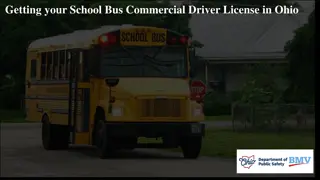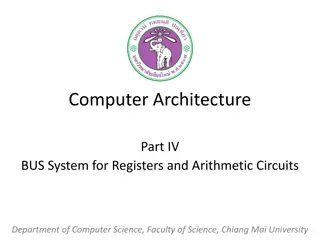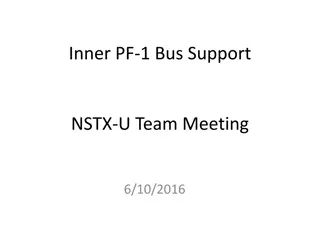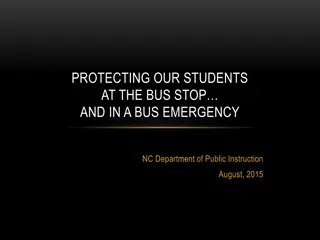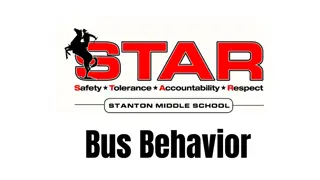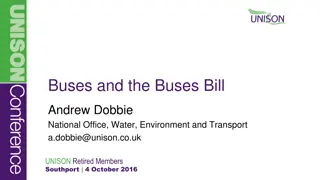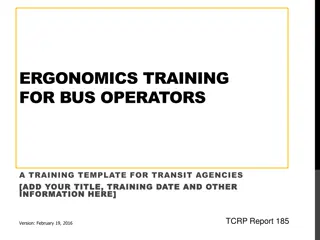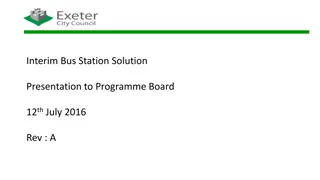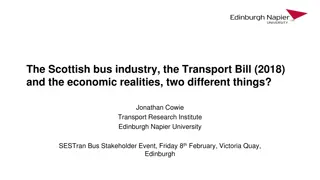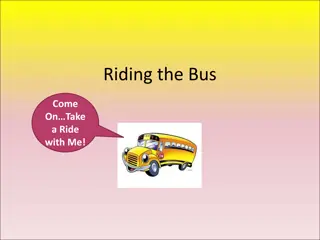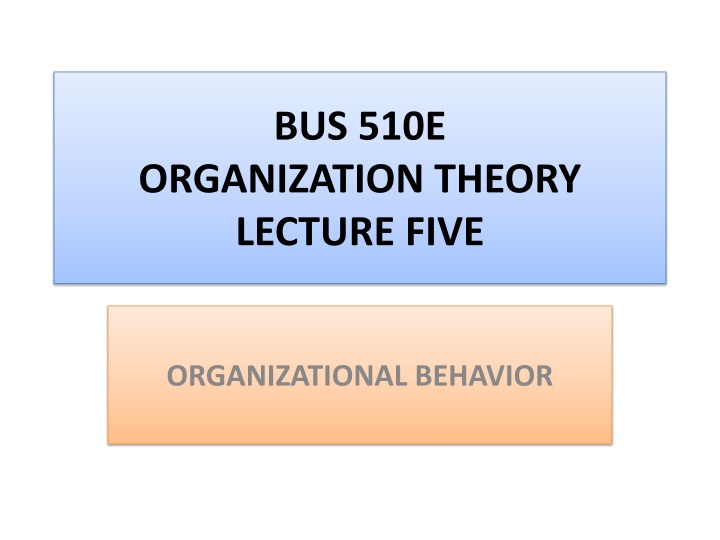
Organizational Behavior and Individual Diversity
Explore the impact of individuals, groups, and structure on behavior within organizations, focusing on improving effectiveness. Delve into topics such as intellectual, psychological, and physical abilities, attitudes, job satisfaction, and more.
Download Presentation

Please find below an Image/Link to download the presentation.
The content on the website is provided AS IS for your information and personal use only. It may not be sold, licensed, or shared on other websites without obtaining consent from the author. If you encounter any issues during the download, it is possible that the publisher has removed the file from their server.
You are allowed to download the files provided on this website for personal or commercial use, subject to the condition that they are used lawfully. All files are the property of their respective owners.
The content on the website is provided AS IS for your information and personal use only. It may not be sold, licensed, or shared on other websites without obtaining consent from the author.
E N D
Presentation Transcript
BUS 510E ORGANIZATION THEORY LECTURE FIVE ORGANIZATIONAL BEHAVIOR
Organizational Behavior A field of study that investigates the impact that individuals, groups, and structure have on behavior within organizations, for the purpose of applying such knowledge toward improving an organization's effectiveness.
Individual Diversity: Ability Intellectual Psychological Ability Ability Physical Ability
FOUR DIMENSIONAL APPROACH Volume Time
Intellectual Ability 1. Quantitative Aptitude 2. Verbal Comprehension 3. Perceptual Speed 4. Inductive Reasoning 5. Deductive Reasoning 6. Spatial Visualization 7. Memory
Psychological Ability Personality Related to Emotion & Values Emotional Stability Extroversion Openness to Experience Agreeableness Conscientiousness
Physical Ability 1. Strength Factors - Dynamic, Trunk, Static, and Explosive Strength 2. Flexibility Factors - Extent and Dynamic Flexibility 3. Other Factors - Body coordination, Balance, Stamina
Attitudes Evaluative Statements or Judgments concerning objects, people, or events Cognitive = Evaluation My pay is low. Affective = Feeling I am angry over how little I m paid. Behavioral = Action I m looking for other work.
Major Causes of Job Satisfaction Interesting jobs that provide training, variety, independence, and control satisfy most employees. Job Condition Money motivates people, but relationship between the pay and job satisfaction disappear after a certain level of compensation is provided. Compensation People who have positive core self-evaluations - who believe in their inner worth and basic competence - are more satisfied with their jobs than those with negative core self-evaluations. Personality Plays a Role
The Basic Emotions anger fear sadness happiness disgust surprise
The Basic Moods Positive or Negative Affect Tense Nervous Stressed Upset Sadness Depressed Bored Fatigued Alert Excited Elated Happy Content Serene Relaxed Calm
OB Application of Emotions and Moods Selection or Recruiting Hiring employees with high emotional intelligence is important for companies such as Starbucks. Decision Making Decision making requires rationality. People in good moods or positive emotions enhance problem-solving skills. Creativity People in good moods tend to be more creative than people in bad moods. They produce more ideas and more options, and other think their ideas are original.
Motivation Moods and emotions are important on motivation. Leadership Effective leaders rely on emotional appeals to help convey their messages. When leaders feel excited, enthusiastic, and active, they may be more likely to energize their subordinates and convey a sense of efficacy, competency, optimism, and enjoyment. See Napoleon. Negotiation Negotiation is an emotional process: angry negotiators who have less information or less power than their opponents have significantly worse outcomes.
Customer Service Negotiation is an emotional process: angry negotiators who have less information or less power than their opponents have significantly worse outcomes. Job Attitudes People who had a good day at work tend to be in a better mood at home that evening, and vice versa. People who have a stressful day at work also have trouble relaxing after they get of work. Workplace Behavior People who feel negative emotions, particularly anger or hostility, are more likely than other to engage in deviant behavior at work. How Managers can Influence Moods Managers can use humor and give their employees small tokens of appreciation for work well done. If leaders are in good moods, group members are more positive, and as a result they cooperate more.
Personality Indicator Myers-Brigs Type Extraverted versus Introverted Extraverted - outgoing, sociable, assertive Introverted quiet and shy Sensing versus Intuitive Sensing practical, in routine and order Intuitive relying on unconscious processes Thinking versus Feeling Thinking to use reason and logic Feeling to rely on personal values and emotions Judging versus Perceiving Judging want control and prefer their world to be ordered and structured Perceiving flexible and spontaneous
Big Five Personality Traits Emotional Stability: calm, self-confident, secure versus nervous, depressed, and insecure Extroversion: sociable, gregarious, and assertive Openness to Experience: Imagination, sensitivity, and curiosity Agreeableness: good natured, cooperative, and trusting Conscientiousness: responsible, dependable, persistent, and organized
Values Terminal Values Instrumental Values Desirable end-states of existence; the goals a person would like to achieve during his or her lifetime Preferable modes of behavior or means of achieving one s terminal values
Linking Personality and Values *** To the Workplace *** Type Personality Characteristics Congruent Occupations Realistic: Prefers physical activities that require skill, strength, and coordination Shy, genuine, persistent, stable, conforming, practical Mechanic, drill press operator, assembly-line worker, farmer Investigative: Prefers activities that involve thinking, organizing, and understanding Analytical, original, curious, independent Biologist, economist, mathematician, news reporter Social: Prefers activities that involve helping and developing other Sociable, friendly, cooperative, understanding Social worker, teacher, counselor, clinical psychologist
BREAK TIME 5 MINUTES TAKE FRESH AIR OUTSIDE
Factors Influencing Perception Perceiver (Personal Characteristics) Target Environment (Characteristics of Target) Attitudes Motives, Interests Experience Expectations Novelty (New) Motion, Sounds, Size Background Proximity, Similarity Time Working setting Social setting
Perception and Making Judgments Distinctiveness Consensus Consistency It refers whether an individual displays different behaviors in different situations If everyone who faces a similar situation responds in the same way, we can say the behavior shows consensus. If an individual who faces a similar situation takes the same action, we can say his behavior shows consistency
Common Shortcuts in Judging Others Category Explanation Selective Perception The tendency to selectively interpret what one sees on the basis of one s interests, background, experience, and attitudes. The tendency to draw a general impression about an individual on the basis of a single characteristic. Evaluation of person s characteristics that is affected by comparisons with other people recently encountered who rank higher or lower on the same characteristics. Judging someone on the basis of one s perception of the group to which that person Halo Effect Contrast Effects Stereotyping
Motivation Motivation is the Processes that account for an individual s intensity, direction, and persistence of effort toward attaining a goal.
Maslows Hierarchy of Needs Theory Self- actualization Esteem (Internal) Social (Internal) Safety (External) Physiological (External)
Motivation Theory X and Theory Y Theory X: Under Theory X, managers believe employees inherently dislike work and must therefore be directed or even coerced into performing it. Theory Y: Under Theory Y, in contrast, managers assume employees like work, are creative, seek responsibility, and can exercise self-direction.
Motivation Hygiene Theory An individual relates intrinsic factors to job satisfaction and associates extrinsic factors with dissatisfaction. Herzberg considered hygiene factors of job satisfaction quality of supervision, pay, company policies, physical working conditions, relationships with others, and job security.
McClellands Theory of Needs @1 Need for achievement is the drive to excel, to achieve in relation to a set of standards, to strive to succeed. @2 Need for power is the need to make others behave in a way in which they would not have behaved otherwise. @3 Need for affiliation is the desire for friendly and close interpersonal relationship.
Contemporary Theories of Motivation 1. Self-Determination Theory 2. Goal-setting Theory 3. Self-Efficacy Theory 4. Reinforcement Theory 5. Equity Theory or Organizational Justice 6. Expectancy Theory
Applications of Motivation Applications Explanation 1. The job characteristics model - skill variety, task identity, task significance, autonomy, and feedback 2. Job redesign by job rotation and job enrichment 3. Alternative work arrangement - flexible time, job sharing, telecommuting 1. Participative management 2. Representative Participation Motivating by Job Design Employee Involvement Using Rewards to motivate employees 1. What to pay - internal and external equity 2. How to pay - variable pay program 3. Flexible benefits 4. Intrinsic rewards - employee recognition programs
Group Behavior Dynamics The Group is two or more individuals, interacting and interdependent, who have come together to achieve particular objectives: they are formal, informal, command, task, interest, and friendship groups. Group properties are based on roles, norms, status, size, and cohesiveness of the group.
Strengths and Weaknesses Group Decision Making Strength: 1 Groups generate more complete information and knowledge. 2 Groups offer increased diversity of views. 3 Groups lead to increased acceptance of a solution. Weakness : 1 There are conformity pressure 2 Group discussion can be dominated by one or a few members. 3 Group decisions suffer from ambiguous responsibility Effectiveness and Efficiency 1 Group decisions are more accurate than the decisions of the average individuals in a group but less accurate than the judgments of the most accurate. 2 If creativity is important, groups tend to be more effective. 3 If effectiveness means the degree of acceptance the final solution achieves, the not again goes to the group.
Group Decision-Making Techniques 1. Interacting Groups: Typical groups in which members interact with each other face to face. 2. Brain-storming: An idea-generation process that specifically encourages any and all alternatives while withholding any criticism of those alternatives. 3. Nominal Group Technique: A group decision-making method in which individual members meet face to face to pool their judgments in a systematic but independent fashion. 4. Electronic Meeting: A meeting in which members interact on computers, allowing for anonymity of comments and aggregation of votes.
Creating Effective Teams 1. Context 1 Adequate resources; 2 Leadership and structure 3 Climate of trust; 4 Performance evaluation and reward systems 2. Composition 1 Abilities of members; 2 Personality; 3 Allocating roles; 4 Diversity; 5 Size of teams; 6 member flexibility; 7 member preferences 3. Process 1 Common purpose; 2 Specific goals; 3 Team efficacy; 4 Conflict levels; 5 Social loafing
END OF THE LECTURE SEE YOU NEXT WEEK



